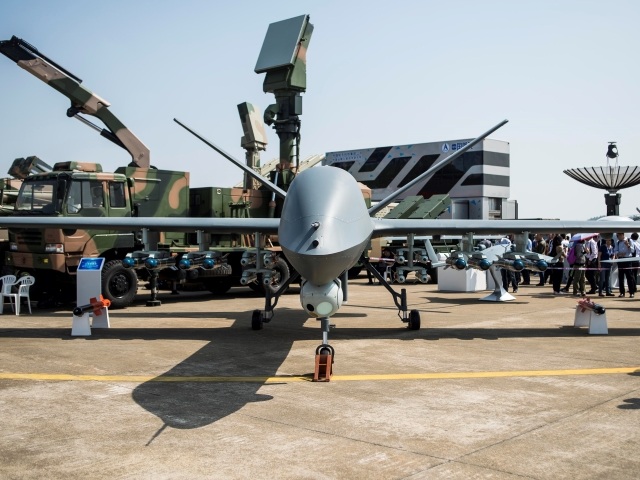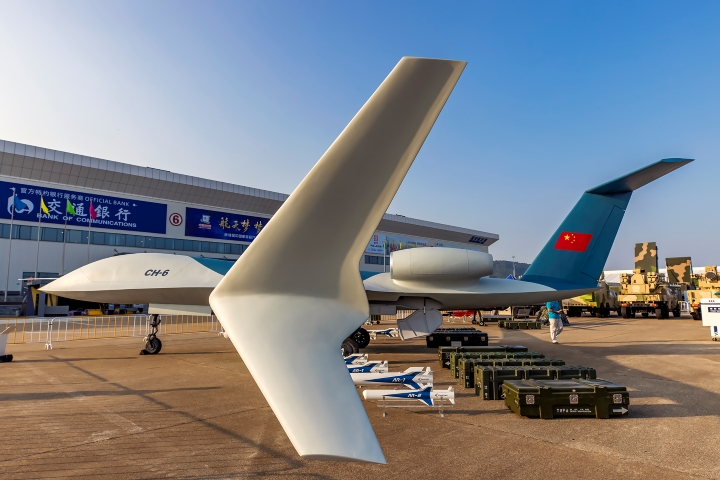China’s state-run Global Times on Wednesday claimed production of China’s CH drones is “running at maximum capacity thanks to heavy market demand” – heavy enough to warrant a new state-of-the-art production line that will become fully operational next year.
The Global Times cited sales of 200 units for the CH-4 “armed reconnaissance drone,” which seems modest compared to global sales for the hottest drone on the market, the Bayraktar TB-2 produced by Turkey’s Baykar corporation.
Baykar reports a three-year order backlog for its drones, which are relatively inexpensive but have performed extremely well on battlefields in Syria, Libya, Nagorno-Karabakh, and, especially, Ukraine. In September, Baykar’s customer list grew to include the United Arab Emirates (UAE) – which wants to buy Baykar drones because they performed so well against UAE-backed forces in Libya.
Baykar has spirited competition in Ukraine from Iran, which was caught supplying its Shahed suicide drones and Mohajer armed UAVs to Russia after months of denials from both parties. After overcoming some early technical hiccups, the Russians appear to be making fairly effective use of the Iranian weapons, although they still seem outclassed by Baykar’s drones.
According to the Global Times, the November 8-13 Airshow China event will see a major rollout of improved CH series UAVs, with a full line of strike and recon drones on offer:
After being upgraded with a domestically developed heavy-fuel engine, the CH-4 armed reconnaissance drone will make its reappearance at the air show. Thanks to the new power source, the CH-4 now has a longer endurance, a longer range, a higher cruise altitude and ceiling, as well as a larger payload capacity.
The latest version of the CH-5 will offer maritime applications, as it can detect information on the sea surface and underwater. As a high-end drone, the CH-7 is characterized by its high-altitude, high-speed, high-endurance and stealth capabilities. The CH-7 can conduct reconnaissance missions without opponents becoming aware of it.
Other known members in the CH drone family include the cheap but effective CH-3, the large CH-6, the tilt-rotor CH-10 and the solar-powered CH-T4. The company also makes munitions suitable for use with the drones.
The Global Times added that two other Chinese drones, the Wing Loong and Twin-Tailed Scorpion, will be on display at the airshow.

CH-5 Medium Altitude Long Endurance UAV System on display at the China International Aviation & Aerospace Exhibition (Airshow China 2016) at China International Aviation Exhibition Center on November 2, 2016 in Zhuhai, China. (Photo by Power Sport Images/Getty Images)
The CH-4 drone is made by the China Aerospace Science and Technology Corporation (CASC). As the Global Times indicated, the CH-4 was recently updated with a domestically-designed engine that burns “heavy fuel,” in this case kerosene, rather than gasoline. CASC engineers said the new engine could help the drone reach altitudes of over 9,000 meters.
The CH-4, which debuted in 2014, is intended for high-altitude land and sea recon and strike missions. The armed version, the CH-4B, can carry up to six missiles with a range of up to 5,000 meters, a capability that helps it evade anti-aircraft fire.
The CH-4 sold well at first, as it was less expensive than competing American designs like the fabled Predator, but China’s customers began falling away in 2018, possibly due to qualms with the CH-4s performance, or political pressure from the U.S. against its allies to avoid purchasing Chinese military products. CASC pushed some of its other designs to address customer dissatisfaction with the CH-4, including the much larger CH-5, which was intended to compete with the best-in-class U.S. MQ-9 Reaper.
By February 2022, international analysts detected a comeback for Chinese drone sales, led by the CH-5 and Wing Loong models. Chinese UAVs sell well in the Middle East, thanks to low cost and easy financing, but they come with the price of increased Chinese influence in foreign military forces. The Chinese are fond of withholding some vital technical information from foreign customers, to make them reliant on Chinese crews for maintenance, and some analysts believe the drones secretly relay information back to Chinese intelligence agencies.
The CH-6 is a relatively new model, unveiled in September 2021, that boasts very long ranges, more reliable performance than earlier models, and the ability to strike submarine targets. On the other end of the spectrum, the CH-3 is a small, cheap armed drone that would most directly compete with the Bayraktar TB-2.

Caihong-6 (CH-6) unmanned aerial vehicle (UAV) is on display ahead of the Airshow China 2021 on September 27, 2021 in Zhuhai, Guangdong Province of China. The China International Aviation & Aerospace Exhibition (Airshow China) 2021 will kick off on September 28 in Zhuhai. (Photo by VCG/VCG via Getty Images)
The Wing Loong medium-altitude drone is a product of Chengdu Aircraft Design & Research Institute (CADI). It is most commonly configured for surveillance missions but can be armed. The more advanced Wing Loong II model, which has a considerably longer range, has been pushed to drone buyers like Morocco to replace their inventory of older CADI drones.
The Twin-Tailed Scorpion, manufactured by Sichuan Tengdun Science and Technology Co., is a hefty logistics and cargo platform that boasts four engines. Tengdun drones made headlines in September when they joined China’s effort to harass Taiwan after U.S. House Speaker Nancy Pelosi visited the island, enraging Beijing. The Scorpion-D model of the drone can carry 1.5 tons of cargo in its 31-square-foot hold.

COMMENTS
Please let us know if you're having issues with commenting.